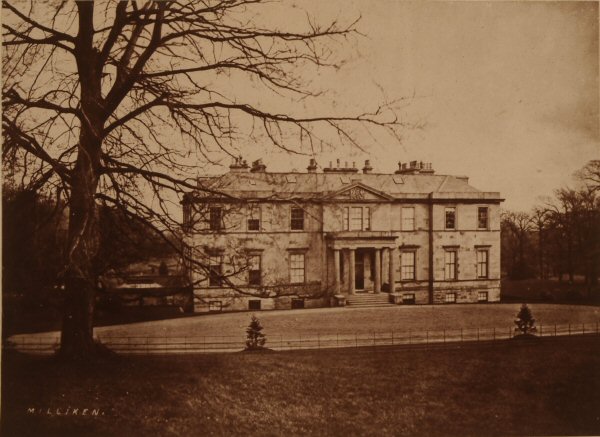
Milliken House

THE seat of Sir Robert John Milliken Napier, of that Ilk, Bart., is situated in the parish of Kilbarchan and county of Renfrew.
The original name of this estate was "Johnstoune." In ancient times it was held by a family of Nisbets, from whom it passed, by marriage, to the Wallaces of Elderslie, and the family of Johnstoune were cadets of that house. (1)
In 1561 the vicarage of Kilbarchan was let to William Wallace of Johnstone for forty merks; this or another "Williame Wallace of Johnstoun, deceist in Julij, 1612." There was a house on the lands at that time, probably surrounded by "barren timber;" for we find an entry in the inventory after his death: "Item seven cuttit esche tries lyand besyd ye place of Johnestoun." (2)
The last of the Wallaces of Johnstone died in the reign of Charles I.; and the estate was acquired by Ludovic Houstoun of Houstoun, and on his death it became the property of his second son George. At the beginning of the eighteenth century Hamilton describes Johnstone as "a very pleasant and desirable place, not far from the watter of Black Carth, a good old house, good old planting, gardens and enclosures."
In 1733 George Houstoun sold Johnstone to James Milliken, who changed the name of the estate to "Milliken." (3) He pulled down the old house and built "an elegant large modern house three stories high, rustic cornered, pavillion roofed, having a platform covered with lead upon the top with ten steps of a stone stair in front up to the main door, which is built after the Ionic order, with a portico having a pediment above." This James Milliken of Milliken died in 1741, leaving a son, James, by his wife, Mary Stephen. She was "a widow and a lady of an opulent fortune in St. Kitts, in the West Indies, where she had a large estate which came with her to the family of Milliken." (4)
James Milliken, the second of Milliken, is described by Semple as a gentleman "who had a dignity of mind and an easy obliging manner." (5) He added considerably to the estate and made many improvements upon it. He married Jane, daughter of Alexander M'Dowall of Garthland, and had two sons, who died without issue, and two daughters, the eldest of whom, Jane, married William Napier of Culcreuch. (6) James Milliken died in 1776, and was succeeded by his grandson, Colonel Robert John Napier. Colonel Napier's son and heir, William, was in 1817 served heir male general of Archibald, third Baron Napier, and succeeded to the Baronetcy held by him. On Sir William's death, in 1852, the estate of Milliken devolved upon his son, the present Baronet. (7)
The old house of Milliken was burnt down in 1801, and the present mansion built in 1836.
(1) Crawford.
(2) Commissary Records, &c.
(3) George Houstoun, while thus selling the estate, retained the name, which was transferred to a property held by the Houstouns in the parish of Paisley, called Easter Cochrane or Quarrelton. Johnstone Castle was afterwards built there, and it is now the family seat of the descendants of George Houstoun.
(4) Major James Milliken was a partner in the South Sugar-house, which was situated on the west side of the Stockwell in Glasgow.
(5) He seems to have taken an interest in Glasgow matters, for in a long list of subscribers to the New Assembly Rooms about the middle of last century, we find his name. He subscribed twenty guineas. Daniel Campbell of Shawfield and General Campbell were the only others who subscribed so large a sum. (Glasgow Past and Present, p. 256.)
(6) The Napiers are the direct descendants of the famous John Napier of Merchistoun, the inventor of Logarithms.
(7) Sir William had two other sons, John Stirling, formerly of Glasgow; he married Janet, daughter of Andrew Brown of Auchentorlie in Renfrewshire, and has issue; and James, who died unmarried; and a daughter Mary, who married Robert Speir of Culdees, whose son is Robert Thomas Napier Speir of Culdees, and whose daughter is Eliza Christian, wife of Archibald Campbell Douglas of Mains.
Back to Contents